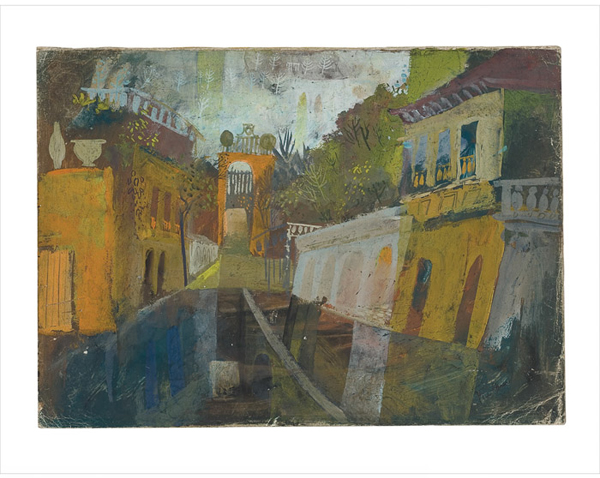Clik here to view.

Middling southern towns possessed of baroque and kinky histories suffered terrible dilemmas in the 1950s and 60s: how to grow and gain respect in the booming post-war era without flushing their rich heritage down the town branch. Lexington, the first capital of Kentucky when it was but a large Virginia county, presented a classic dilemma marked by the arrival of IBM's typewriter division and surrounded by a steadily metastasizing suburbia gobbling up its famous white-fenced horse farms. Wrecking balls for high-rise banks replaced the quaint old hotels as fast-food cholesterol bankrupted ancient neighborhood eateries. It was the America that terrified European preservationists.
But in Lexington as elsewhere there were exceptions, scant tribes of artists, tale tellers and eccentrics who both refused to sell off the past even as they embraced a new kind of future--and for Kentucky none cast a sharper shadow than a brilliant young painter who trolled the back streets picking up young fellows (I was almost one of them) and entertaining the glamorous horse aristocracy at their Bourbon-drenched Derby Day parties.
Clik here to view.

Henry Faulkner's origins are as obscure as many of his surreal images. He claimed to be a poor cousin to the much more famous Faulkner of Mississippi, though there's little evidence of the connection. He told people that he was born in Egypt, Kentucky, a hamlet with a good sounding name deep in Appalachian Breathitt County (known as "Bloody Breathitt for its unionizing mine workers and the mine bosses armed goons), though other records suggest he was born several counties to the west, and he was largely raised in foster homes after his mother died, eventually managing to escape by rail to Lexington--it's said--determined to make his name as a poet-performer and painter. The poetry, such little of it as has survived, is of middling note, but several hundred of his drawings and paintings, developed under formal training in Louisville and Los Angeles, have been favorably compared to the great colorists and surrealists of the inter-war years. To those who know or remember, they also stand as witness to the largely erased bohemian and esthetic heritage for which Lexington was known from the Forties through the Sixties.
A new film, In Search of a Unicorn (and possibly a specialized museum) is under production aimed at capturing Faulkner's place in Lexington's heritage. Folk and Bluegrass radio impressario Ed Commons (Red Barn Radio) has teamed up with Natasha Williams and the Balagula Theatre to produce the film. Williams moved to Lexington directly from Kiev, where she'd worked in classical theatre, a decade after Faulkner's death. She immediately fell in with one of Faulkner's dearest friends who ever since has regaled her with Faulkner's far flung life stories--from the time he worked as a hustler in California to his adventures in Sicily. "Henry's paintings and his story reminded me of my favorite painter, Georgian Nico Pirosmani, and that's how my love affair with Henry started," she told me when I passed through Kentucky last fall.
Clik here to view.

"There is something very special about someone like that. So many people think of [Faulkner] as a jester, this performer with strange behavior. You start digging into the whole picture, and you find a fascinatingly talented, complex, intelligent... person who was friends with Truman Capote and Tennessee Williams and whose work was collected by Marlon Brando. Betty Davis. Bertolt Brecht, Vincent Price, even Phyllis George and who was in the insane asylum with Ezra Pound. Ezra Pound took him under his wing."
Eccentric artists abound across the American South, but what fascinated Ed Commons was not only Faulkner-the-painter, but Faulkner-the-man--a cross dressing performer who circulated as easily among Lexington's aristocracy--including two famously wild rich women from the horse world, Anita Madden and Mrs. Cornelius Vanderbilt Whitney--as among the sex trade boys who cruised the parking lot behind the city's all-purpose gay bar, The Living Room.
A premature animal rights activist, Faulkner often as not arrived in the company of his most loyal companion, Alice, a white goat.
Clik here to view.

Eccentricities aside, Faulkner would have amounted to little more than a local color character but for his paintings, variously compared to Miro, Chagall and Klimt for his mélange of color and the fantastic. The pastels and water colors range from abstracted small towns in Kentucky to misty California landscapes to the urban cityscapes he saw traveling through France and Italy, where the work was shown in Parisian and Roman galleries. Many of the sketches are of the boys and men in his life.
Clik here to view.

What happens to the collection of 200-plus drawings and paintings sold in early November by the estate of Faulkner's accountant and patron, Greene A. Settle, to the First Southern National Bank in Eastern Kentucky bank, remains unclear. The bank reportedly saw the collection as a sound investment, and there have been efforts in Lexington to collaborate with the bank in opening a Faulkner Museum that would both promote the work as a major element in the city's artistic history.
Images courtesy of Greene A. Settle Collection owned by First Southern National Bank.